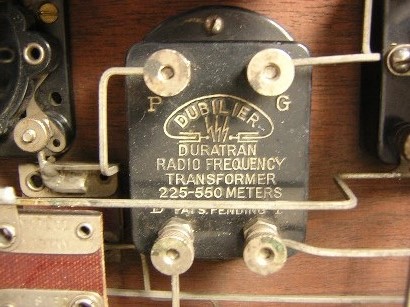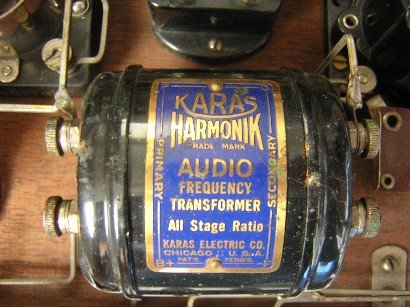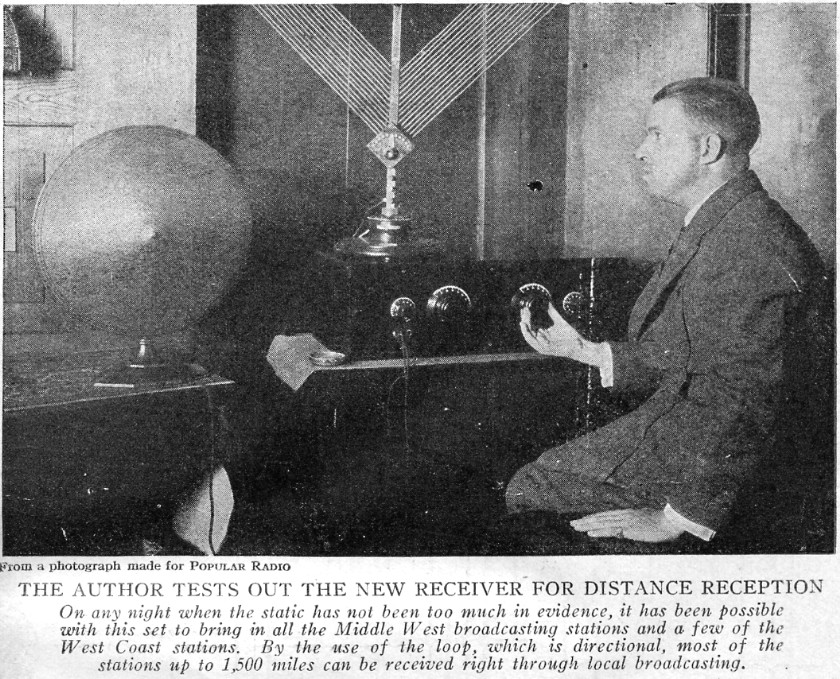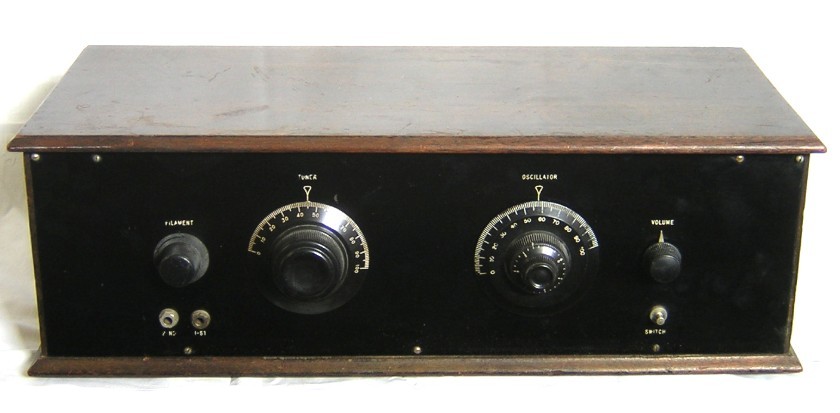Cockaday/Haynes-Griffin IF Transformers
Dubilier “Duratran” untuned radio frequency transformer.

General Instrument Corp tuning capacitor.
Above is a schematic diagram of the second harmonic reflexed superheterodyne. Reflexing is a radio method of making some tubes do two functions instead of one. The following is a simplified description of how the signal moves through the Cockaday superhet. The radio frequency signal is tuned in with the loop and its associated tuning capacitor and applied to the grid of tube 1 (via capacitor C). Tube 1 amplifies the radio frequency signal (and, as will be seen, it also amplifies the audio frequency signal). Next, the radio frequency signal goes through the untuned radio frequency transformer (RFT) to the grid of tube 2. Tube 2 functions as both a radio frequency oscillator and a first detector; the second harmonic of the oscillator mixes with the received signal and produces the IF frequency. The new signal is now amplified at the IF frequency in the next three tubes, numbered 3, 4, and 5. After detection in tube 6, the audio frequency signal is sent back to tube 1 (via the audio transformer AFT) where it is amplified as an audio signal. From tube 1 the audio signal passes through the primary of the untuned radio frequency transformer to the two stage resistance coupled audio amplifier, tubes 7 and 8. Reflexing works because the two signals (radio frequency and audio frequency) are vastly different, and high and low pass filters keep the two signals seperate and route them where they need to go [Capacitor C passes the RF signal but blocks the AF signal, and transformer AFT passes the AF signal but blocks the RF signal. In a similar fashion, transformer RFT the blocks the AF signal and passes it to the audio amplifier and accepts the RF signal and passes it to the first detector]. Refer to the RCA AR-812 for another example of a reflexed second harmonic superheterodyne.
The filter transformer (first in the line) was measured with its tuning capacitor installed. Strangely, its characteristics are not that much different than the untuned IF transformers. The last transformer, #4, was measured like the other transformers (by changing a few wires and using A- for the secondary winding reference and no grid leak. Most often I will not make these wiring changes to the second detector and I will measure the last IF transformer with the grid leak resistor and capacitor in place and the secondary winding referenced to A+).

Haynes-Griffin advertisement from the March, 1925, Popular Radio magazine.
.
|
Type |
Peak Freq. |
Lower 3 dB |
Upper 3 dB |
Bandwidth |
Relative gain |
Pri. ohms |
Sec. ohms |
|
Conical, #1 (filter) with cap |
128.6 KC |
114.7 KC |
146.6 KC |
31.9 KC |
11.0 |
38.1 |
140.3 |
|
Conical, #2 |
128.8 KC |
111.8 KC |
144.5 KC |
32.7 KC |
9.5 |
82.5 |
138.6 |
|
Conical, #3 |
125.4 KC |
108.6 KC |
140.7 KC |
32.1 KC |
9.2 |
81.5 |
132.4 |
|
Conical, #4 |
128.6 KC |
110.8 KC |
145.3 KC |
34.5 KC |
9.0 |
77.5 |
148.4 |




Precision Autodyne Coupler.


Rear angle view of my set. The set was professionally built and it’s in excellent original condition.

My example of the Cockaday has an engraved panel and it was probably built by a professional builder. I mainly purchased the set because I was highly interested in its complex circuit. Cockaday’s circuit is very interesting and the radio is a welcome addition to my collection.
Here are a few particulars of my set:
1. Front panel measures 24” by 7” by 3/16”
2. Haynes-Griffin conical IF transformers
3. Karas “Harmonik” audio transformer
4. Precision autodyne coupler (oscillator coils)
5. Dubilier “Duratran” radio frequency transformer
6. Federal tube sockets
7. Benjamin shock-resistant tube sockets for the 1st and 2nd detectors
8. General Instrument Corp tuning caps
9. AMSCO rheostat
10. CRL potentiometer
11. Eight tubes

The Cockaday superheterodyne was the brainchild of the noted electrical engineer Lawrence M. Cockaday. The construction article for this set appeared in the January, 1925, Popular Radio magazine. The article boasted a number of new advances in superheterodyne technique:
1. The circuit operated on the reflexed second harmonic principle.
2. It used loop tuning that was connected to a single stage of radio-frequency amplification, where feedback was prevented by the Pliodyne method.
3. It had an autodyne oscillator (a single tube that functioned as both an oscillator and first detector) utilizing the “second harmonic” principle.
4. It had an IF amplifier with three stages of amplification (using Haynes Griffin conical IF transformers).
5. It had a vacuum tube second detector, the output of which was reflexed on the first radio-frequency amplifying tube.
6. It used a new method of reflexing that used a shunt connection of the secondary of the audio transformer instead of the usual series connection.
7. It used two additional stages of resistance coupled audio amplification.

Karas “Harmonik” audio frequency transformer.
Haynes-Griffin conical IF transformers.
Close-up of the engraved panel.